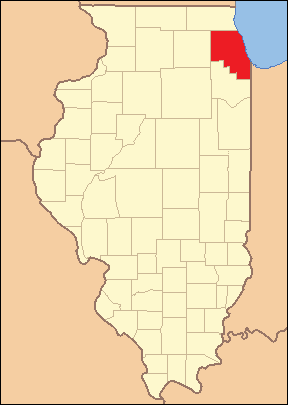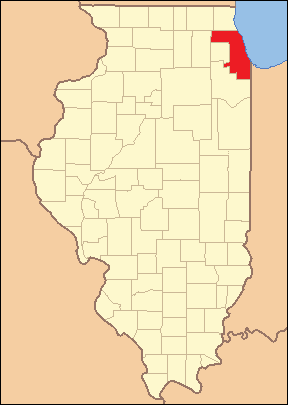Cook County, Illinois
Cook County, Illinois is a county located in the northeastern part of the United States, within the state of Illinois. As of the 2020 United States Census, it is the most populous county in Illinois and the second-most populous county in the United States, following Los Angeles County, California. The county seat is Chicago, which is also the largest city in Illinois and the third-most populous city in the United States. Cook County is one of the major centers of commerce, finance, culture, and industry in the Midwest, and it plays a significant role in the national economy.
History[edit | edit source]
Cook County was established on January 15, 1831, from parts of Putnam County. It was named after Daniel Pope Cook, one of the early Illinois politicians and the first Attorney General of the State of Illinois. The county's establishment was part of the rapid expansion and settlement of the American frontier during the early 19th century. Over the years, Cook County has played a pivotal role in the development of Illinois, both economically and culturally. The Great Chicago Fire of 1871 and the World's Columbian Exposition of 1893 are among the historical events that have shaped the county and its development.
Geography[edit | edit source]
Cook County covers an area of approximately 1,635 square miles, making it the second-smallest county in Illinois by land area. Despite its relatively small size, the county features a diverse range of geographical features, from the urban sprawl of Chicago to the suburban and rural areas that surround the city. The county is bordered by Lake Michigan to the east, providing a significant natural resource and recreational area for residents and visitors alike.
Demographics[edit | edit source]
According to the 2020 Census, Cook County had a population of approximately 5,275,541 people. The county is ethnically and culturally diverse, with a significant number of residents being immigrants or descendants of immigrants from all over the world. This diversity is reflected in the county's neighborhoods, cultural institutions, and festivals.
Economy[edit | edit source]
Cook County's economy is one of the largest and most diverse in the United States. The county is a major hub for finance, with the Chicago Board of Trade and the Chicago Mercantile Exchange being key components of the global financial system. Additionally, the county is home to numerous Fortune 500 companies, major medical centers, universities, and research institutions. The economy is also supported by a robust tourism industry, driven by attractions such as the Art Institute of Chicago, Millennium Park, and the Willis Tower.
Government and Politics[edit | edit source]
Cook County operates under a home rule form of government, with the Cook County Board of Commissioners serving as the legislative body. The board is headed by the Cook County Board President, who is elected countywide. The county is known for its political significance both within Illinois and nationally, often playing a crucial role in state and federal elections.
Education[edit | edit source]
The county is home to several prestigious universities and colleges, including the University of Chicago, Northwestern University, and Loyola University Chicago. These institutions contribute to the county's reputation as a center for higher education and research.
Transportation[edit | edit source]
Cook County has a comprehensive transportation network that includes major airports such as O'Hare International Airport and Midway International Airport, extensive public transit systems like the Chicago Transit Authority (CTA) buses and trains, and a vast network of highways and roads. This infrastructure supports the county's economy and facilitates the movement of people and goods throughout the region and beyond.
Search WikiMD
Ad.Tired of being Overweight? Try W8MD's physician weight loss program.
Semaglutide (Ozempic / Wegovy and Tirzepatide (Mounjaro / Zepbound) available.
Advertise on WikiMD
|
WikiMD's Wellness Encyclopedia |
| Let Food Be Thy Medicine Medicine Thy Food - Hippocrates |
Translate this page: - East Asian
中文,
日本,
한국어,
South Asian
हिन्दी,
தமிழ்,
తెలుగు,
Urdu,
ಕನ್ನಡ,
Southeast Asian
Indonesian,
Vietnamese,
Thai,
မြန်မာဘာသာ,
বাংলা
European
español,
Deutsch,
français,
Greek,
português do Brasil,
polski,
română,
русский,
Nederlands,
norsk,
svenska,
suomi,
Italian
Middle Eastern & African
عربى,
Turkish,
Persian,
Hebrew,
Afrikaans,
isiZulu,
Kiswahili,
Other
Bulgarian,
Hungarian,
Czech,
Swedish,
മലയാളം,
मराठी,
ਪੰਜਾਬੀ,
ગુજરાતી,
Portuguese,
Ukrainian
Medical Disclaimer: WikiMD is not a substitute for professional medical advice. The information on WikiMD is provided as an information resource only, may be incorrect, outdated or misleading, and is not to be used or relied on for any diagnostic or treatment purposes. Please consult your health care provider before making any healthcare decisions or for guidance about a specific medical condition. WikiMD expressly disclaims responsibility, and shall have no liability, for any damages, loss, injury, or liability whatsoever suffered as a result of your reliance on the information contained in this site. By visiting this site you agree to the foregoing terms and conditions, which may from time to time be changed or supplemented by WikiMD. If you do not agree to the foregoing terms and conditions, you should not enter or use this site. See full disclaimer.
Credits:Most images are courtesy of Wikimedia commons, and templates, categories Wikipedia, licensed under CC BY SA or similar.
Contributors: Prab R. Tumpati, MD




